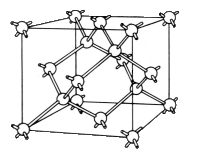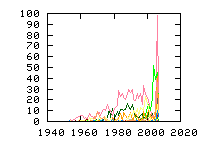« Previous
Next »
(9 hits, 1/1)
Showing
10, 25, 50, 100, 500, 1000, all papers per page.
Sort by:
last publication date,
older publication date,
last update date.
- 1. Microelectron. Reliability 45, 71 (2005) , “A comprehensive model of PMOS NBTI degradation ”,Negative bias temperature instability has become an important reliability concern for ultra-scaled Silicon IC technology with significant implications for both analog and digital circuit design. In this paper, we construct a comprehensive model for NBTI phenomena within the framework of the standard reaction–diffusion model. We demonstrate how to solve the reaction–diffusion equations in a way that emphasizes the physical aspects of the degradation process and allows easy generalization of the existing work. We also augment this basic reaction–diffusion model by including the temperature and field-dependence of the NBTI phenomena so that reliability projections can be made under arbitrary circuit operating conditions. (Read more)
- 2. J. Appl. Phys. 94, 1 (2003) , “Negative bias temperature instability: Road to cross in deep submicron silicon semiconductor manufacturing”,We present an overview of negative bias temperature instability (NBTI) commonly observed in p-channel metal–oxide–semiconductor field-effect transistors when stressed with negative gate voltages at elevated temperatures. We discuss the results of such stress on device and circuit... (Read more)
- 3. Appl. Phys. Lett. 81, 2397-2399 (2002) , “Hydrogen redistribution induced by negative-bias-temperature stress in metal–oxide–silicon diodes”, Ziyuan LiuPoly-Si/SiO2/Si diodes in which oxides were grown thermally under wet oxidation conditions and subsequently treated by a post-oxidation anneal (POA) have been characterized electrically and chemically before and after applying negative-bias-temperature stress (NBTS). It was confirmed that... (Read more)
- 4. Microelectron. Reliability 45, 57 (2005) , “Characterization of interface defects related to negative-bias temperature instability SiON/Si<100> systems ”,Interface defects related to negative-bias temperature instability (NBTI) in an ultrathin plasma-nitrided SiON/ Si<100> system were characterized by using conductance–frequency measurements, electron-spin resonance measure- ments, and synchrotron radiation X-ray photoelectron spectroscopy. It was confirmed that NBTI is reduced by using D2-annealing instead of the usual H2-annealing. Interfacial Si dangling bonds (Pb1 and Pb0 centers) were detected in a sample subjected to negative-bias temperature stress (NBTS). Although we suggest that NBTS also generates non-Pb defects, it does not seem to generate nitrogen dangling bonds. These results show that NBTI of the plasma-nitrided SiON/Si system is predominantly due to Pb depassivation. Plasma nitridation was also found to increase the Pb1/Pb0 density ratio, modify the Pb1 defect structure, and increase the latent interface trap density by generating Si suboxides at the interface. These changes are likely to be the causes of NBTI in ultrathin plasma-nitrided SiON/Si systems. (Read more)
- 5. Appl. Phys. Lett. 82, 3677-3679 (2003) , “Interface defects responsible for negative-bias temperature instability in plasma-nitrided SiON/Si(100) systems”, Shinji Fujieda, Yoshinao Miura, and Motofumi SaitohInterface defects generated by negative-bias temperature stress (NBTS) in an ultrathin plasma- nitrided SiON/Si(100) system were characterized by using D2 annealing, conductance-frequency measurements, and electron-spin resonance measurements. D2 annealing was shown to lower... (Read more)
- 6. J. Appl. Phys. 104, 014106 (2008) , “Analysis of electrically biased paramagnetic defect centers in HfO2 and HfxSi1−xO2 / (100)Si interfaces”, P. T. Chen, B. B. Triplett, J. J. Chambers, L. Colombo, P. C. McIntyre, and Y. NishiThis study reports on the first experimental observations of electrically biased paramagnetic defects at 800 °C N2 annealed HfxSi1−xO2 (x=0.4, and 0.6)/(100)Si and HfO2/(100)Si interfaces in metal oxide silicon... (Read more)
- 7. Phys. Rev. Lett. 83, 372 (1999) , “Hydrogen Electrochemistry and Stress-Induced Leakage Current in Silica”, Peter E. Bl?chl and James H. StathisHydrogen-related defects in oxygen-deficient silica, representing the material of a thermal gate oxide, are analyzed using first-principles calculations. Energetics and charge-state levels of oxygen vacancies, hydrogen, and their complexes in the silica framework are mapped out. The neutral hydrogen... (Read more)
- 8. Phys. Rev. Lett. 92, 087601 (2004) , “Hydrogen-Release Mechanisms in the Breakdown of Thin SiO2 Films”, J. Suñé and E. Y. WuThe mechanism of hydrogen release from the anode Si/SiO2 interface that triggers defect generation and finally the dielectric breakdown of the oxide in metal-oxide-semiconductor structures is investigated. Extensive experimental charge-to-breakdown statistics are used to derive the defect... (Read more)
- 9. Appl. Phys. Lett. 81, 1818 (2002) , “Interface structures generated by negative-bias temperature instability in Si/SiO2 and Si/SiOxNy interfaces”, J. Ushio, T. Maruizumi, K. Kushida-AbdelghafarWe used a density functional method to investigate the mechanism of negative-bias temperature instability (NBTI) and resultant structural changes of Si/SiO2 and Si/SiOxNy interfaces. The reaction energies for the water- and hydrogen-originated... (Read more)
« Previous
Next »
(9 hits, 1/1)
Showing
10, 25, 50, 100, 500, 1000, all papers per page.
Sort by:
last publication date,
older publication date,
last update date.
All papers (3399)
Updated at 2010-07-20 16:50:39
Updated at 2010-07-20 16:50:39
(view as: tree
,
cloud
)
| 1329 | untagged |
Materials
(111 tags)
Others(101 tags)
Technique
(46 tags)
Details
(591 tags)
Bond(35 tags)
Defect(interstitial)(18 tags)
Defect(vacancy)(15 tags)
Defect-type(19 tags)
Element(65 tags)
Energy(8 tags)
Isotope(56 tags)
Label(303 tags)
Sample(17 tags)
Spin(8 tags)
Symmetry(15 tags)

